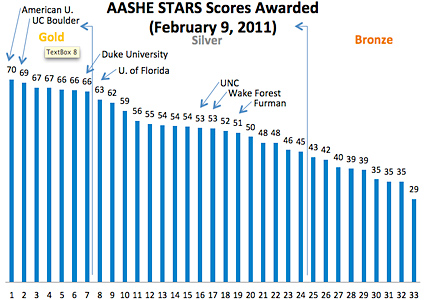Do you remember elementary school when teachers and parents gave out little gold star stickers when you did well on a test or completed your house chores? Sometimes they were red or green or blue or silver, but gold was always the best. Well, it turns out we don’t seem to lose interest in garnering those little tokens of accomplishment just because we grow up.
So it is with warm apple pie enthusiasm I tell you now that last week, Duke got a gold star for sustainability. I only hope we hang it on our collective, proverbial fridge because it’s not without merit. We should walk by this gold star every morning for at least a week and like it so much we want to earn more. Since this is 2011, and we have to adjust for inflation, materialism and the marital market’s preferences, platinum is now the best kind of star. Gold ranks second.
Now then, the assignment. Association for the Advancement of Sustainability in Higher Education’s Sustainability Tracking Assessment and Rating System aims to be “a transparent, self-reporting framework for colleges and universities to gauge relative progress toward sustainability.” So basically a rating system that, like U.S. Green Building Council’s Leadership in Energy and Environmental Design rating system for buildings, awards points for meeting certain criteria and assigns a rating of platinum, gold, silver or bronze. Also like LEEDS, STARS is a member developed and driven standard with all the associated benefits and drawbacks.
Tavey Capps, environmental sustainability coordinator at Duke, identified in an e-mail the following aspects of the system as most important: its transparency in reporting and evaluation (all data is publicly available on the web); the absolute scale leaves room to measure improvement and its comprehensive approach. The system measures impacts equally in the three main categories of education and research, operations and planning, administration and engagement. Capps also noted the lack of perceived bias toward the endowment holdings—a clear sore spot for Duke when it comes to other ratings systems.

Before we dive down, let’s stop and check out the numbers! Emphasis has been placed on the fact that STARS is a rating system, not a ranking system. That being said, there is no trend data to rate progress (it’s new!) and they give out points and list numbers to determine a rating, so... I had to rank everyone. I couldn’t help myself.
The stats so far: There are currently about 250 colleges and universities registered to submit and receive ratings. Ratings are good for three years. Thirty-three have received their scores. Of those there are no platinum, seven gold, 17 silver and nine bronze. Duke just barely squeaked into the gold category. But, hey, it’s like a grade, an A is an A in your GPA, right?
Of schools registered in the program, Capps considers Yale, Cornell, Stanford, Emory, Columbia, UNC at Chapel Hill and Furman to be our peer institutions. The only two of those schools assigned scores so far, UNC and Furman, both fall a good 10 points behind Duke and solidly in the silver. Don’t count them out though, the whole point is to learn from each other, and it’s possible these peers have some reasonably cool programs that Duke could adapt.
I can’t go through all the points here. But, Duke’s detailed scores reveal our own accomplishments and opportunities. For instance, we scored best in the planning, administration and engagement category with 74.38 percent of the points awarded. This category, however, reveals a gap in investment points that are unlikely to change based on institutional preferences, and a gap in public engagement. An additional level of detail indicates that a sustainability plan would get us points as would an employee sustainability educators program. Duke is already pushing forward on its efforts in public engagement and the Campus Sustainability Committee’s education subcommittee is developing a program to train educators.

The most intriguing idea here is the opportunity to develop a comprehensive campus sustainability plan. Such a plan would address areas outside the Climate Action Plan’s purview—like water, waste reduction, purchasing and land use—and set targets and objectives to help guide policy and programming decisions within the University. Capps indicates her support in her e-mail, also saying that “developing targets for future improvement would allow us to better measure and publicize progress” in these areas.
I’m all for it. I’ve often written columns addressing just those topics and wondered a little that they didn’t fit nicely into the CAP. The merits and demerits of such an investment of time and resources could be further explored, but I believe it would be a worthwhile exercise. A clearer articulation of our goals would eliminate the roadblocks I encounter as a student group leader dealing with these issues.
Going forward, will Duke focus on getting more points, brown-nosing, as it were? It might look like that, but it is my hope that while Duke has garnered Gold STARS, the stars are not all we care about.
Liz Bloomhardt is a fourth-year graduate student in mechanical engineering. Her column runs every other Friday.
Get The Chronicle straight to your inbox
Signup for our weekly newsletter. Cancel at any time.
